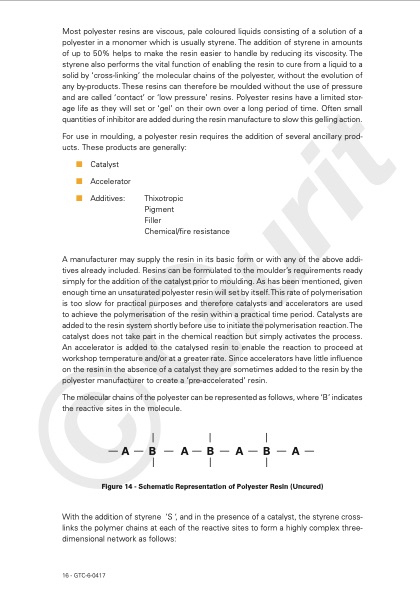
PDF Publication Title:
Text from PDF Page: 018
Most polyester resins are viscous, pale coloured liquids consisting of a solution of a polyester in a monomer which is usually styrene. The addition of styrene in amounts of up to 50% helps to make the resin easier to handle by reducing its viscosity. The styrene also performs the vital function of enabling the resin to cure from a liquid to a solid by ‘cross-linking’ the molecular chains of the polyester, without the evolution of any by-products. These resins can therefore be moulded without the use of pressure and are called ‘contact’ or ‘low pressure’ resins. Polyester resins have a limited stor- age life as they will set or ‘gel’ on their own over a long period of time. Often small quantities of inhibitor are added during the resin manufacture to slow this gelling action. For use in moulding, a polyester resin requires the addition of several ancillary prod- ucts. These products are generally: ■ Catalyst ■ Accelerator ■ Additives: Thixotropic Pigment Filler Chemical/fire resistance A manufacturer may supply the resin in its basic form or with any of the above addi- tives already included. Resins can be formulated to the moulder’s requirements ready simply for the addition of the catalyst prior to moulding. As has been mentioned, given enough time an unsaturated polyester resin will set by itself. This rate of polymerisation is too slow for practical purposes and therefore catalysts and accelerators are used to achieve the polymerisation of the resin within a practical time period. Catalysts are added to the resin system shortly before use to initiate the polymerisation reaction. The catalyst does not take part in the chemical reaction but simply activates the process. An accelerator is added to the catalysed resin to enable the reaction to proceed at workshop temperature and/or at a greater rate. Since accelerators have little influence on the resin in the absence of a catalyst they are sometimes added to the resin by the polyester manufacturer to create a ‘pre-accelerated’ resin. The molecular chains of the polyester can be represented as follows, where ‘B’ indicates the reactive sites in the molecule. ABABABA Figure 14 - Schematic Representation of Polyester Resin (Uncured) With the addition of styrene ‘S ‘, and in the presence of a catalyst, the styrene cross- links the polymer chains at each of the reactive sites to form a highly complex three- dimensional network as follows: 16 - GTC-6-0417PDF Image | GUIDE TO COMPOSITES

PDF Search Title:
GUIDE TO COMPOSITESOriginal File Name Searched:
guide-to-composites.pdfDIY PDF Search: Google It | Yahoo | Bing
5,000 BF Shipping Container Lumber Dry Kiln For Quality Lumber The 5,000 BF container kiln consists of one 40 foot high-cube aluminum shipping container... More Info
Shipping Container Lumber Dry Kilns by Global Energy Global Energy designed and developed the container kiln back in 1991. The purpose is to give access to portable sawmill owners, furniture makers, and small business the value added profit of dry kiln lumber and quality hardwoods... More Info
Vacuum Kiln Conversion Kit for Lumber and Wood Dry Kilns Convert your existing conventional dry kiln into a fast drying vacuum kiln. Similar to vacuum bagging in the boat building and aircraft industry, we have come up with a proprietary process which allows you to build a very simple vacuum kiln at a fraction of the price, and without the intensive conventional metal chamber structure... More Info
Vacuum Pump Cart System for Bagging Clamping Wood Drying and more Vacuum Cart with 2HP Pump and Dual Pistons with multiple multiplex vacuum ports and liquid reservoir... More Info
Vacuum Bagging Basics Vacuum bagging is a method of clamping, which has traditionally been used in the composites industry, but can also be used for vacuum drying materials, including wood products... More Info
| CONTACT TEL: 608-238-6001 Email: greg@globalmicroturbine.com | RSS | AMP |